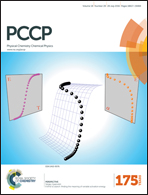Thermometry and up-conversion luminescence of Yb3+–Er3+ co-doped Na2Ln2Ti3O10 (Ln = Gd, La) phosphors
Abstract
Yb3+/Er3+-ion co-doped Na2Ln2Ti3O10 (Ln = Gd, La) up-conversion (UC) phosphors were successfully synthesized by a sol–gel method, and their crystal structures were characterized by powder X-ray diffraction. Dazzling yellow-greenish light was emitted under the excitation of 980 nm near-infrared (NIR) light, composing green and red emission bands from the 2H11/2/4S3/2 → 4I15/2 and 4F9/2 → 4I15/2 transitions of Er3+, respectively. The optimal composition and synthesis parameters were determined according to their UC emission intensity. The photon absorption and emission processes were illustrated based on the UC mechanism, in which energy transfer (ET) from Yb3+ to Er3+ plays a pivotal role and has been proved by the variation of green emission lifetime in Er3+ singly and Yb3+/Er3+ co-doped Na2Ln2Ti3O10 samples. The temperature-dependent fluorescence intensity ratios (FIR) of the two thermal coupled energy level (TCL) emission from 2H11/2 → 4I15/2 (526 nm) and 4S3/2 → 4I15/2 (549 nm) were calculated in the range of 290–490 K, and their sensitivity values were approximately 0.0058 K−1 for Na2Gd2Ti3O10 at 490 K and 0.0061 K−1 for Na2La2Ti3O10 at 470 K, as potential optical temperature sensor.


 Please wait while we load your content...
Please wait while we load your content...